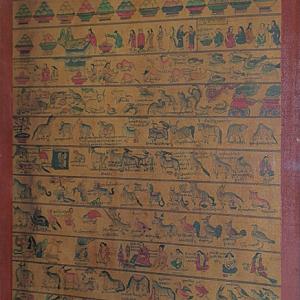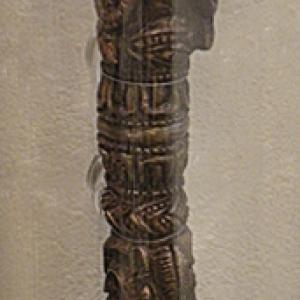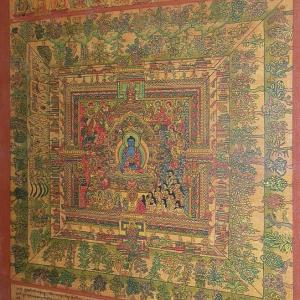The Traditional Tibetan Medicine [gSowa Rigpa “knowledge and science of healing”] is the result of the fusion of elements from the Ayurvedic tradition, the Greek classical system and the complex Chinese medical system, re-elaborated and integrated in the Tibetan philosophical, historical and cultural context, in the Bon culture and the Buddhist tradition.
According to tradition, the fundaments of Tibetan medicine are gathered together in the Four Tantras of the Medical Science [Rgyud-bzhi] or Tantra of the secret instructions on the eight branches of essence of the immortality elixir.
Codified and expressed by Buddha Śākyamuni, acting as Bhaişajyaguru ‘Lord of the Medicaments’, handed down throughout the centuries and assimilated in the different lineages of Tibetan tradition from master to disciple, in the 17th century they were eventually collected in a series of texts and illustrations forming the Blue Beryl (Vaidurya sNgon-po), and from then on they have been acknowledged as the foundation of Tibetan medical science.
Traditional Tibetan Medicine, holistic and precautionary, is based on a complex philosophical and cosmological system, which defines an integrated system of health care, viewed as a balance of body, mind and spirit, also including the Dharma practice.
The main cause of every disease is the basic ignorance from which ‘specific’ causes arise, i.e. the three poisons of attachment, hate and confusion.
By observing and carefully considering each symptom, it is possible to deduce almost all diseases, which have to be treated according to a complex system of interrelations. These include the qualities of the patient, of the medicines and of the doctor, which must be evaluated also taking into account factors like diet, behavior, seasons, elements, the senses and what their experience.
"Specific" causes generate in their turn ‘immediate’ causes or ‘humors’, namely ‘wind’ (rlung), ‘bile’ (mkhris-pa) and ‘flegma’ (bad-kan). When they are not balanced or are subject to transformation, they start spreading in all directions
The health of body, speech and mind is the result of different states of balance. A state of disharmony is at the base of every disease.
In Tibetan Medicine, diseases are divided into four main types:
- temporary or ‘apparent’ diseases (ltar-snang ‘phral), which can resolve spontaneously or even when inadequate treatments have been administered;
- ‘imaginary’ diseases (kun-btags gdon), which are caused by demonic forces and must be treated with rituals;
- ‘absolute’ diseases (yongs-grub tshe), which shorten life expectancy and must be treated with all known therapeutic means;
- diseases that are caused by past actions or “karmic diseases” (gzhan-dbang sngon-las), which are incurable.
All treatments aim at balancing the different elements. This objective may be achieved through diets, changes in behavior and herbal mixtures, or therapies like moxibustion, acupuncture, heat therapy, massage therapy, thermal baths, phlebotomy, and spiritual practices.
Body, universe and nature are made up of the same elements and are in a constant relation to one another.
Physical conditions and emotions are interconnected.
The patient to be treated and the doctor who treats are connected.
Ignorance and knowledge are connected.
The ideal doctor is someone who combines a strong medical knowledge with great wisdom and compassion, whose interior qualities are as important as his professional experience but, above all, is someone who can help the patient develop a genuine awareness.
sMan bla’i mDo chog yid bzhin dbang rgyal

sMan bla’i mDo chog yid bzhin dbang rgyal

sMan bla’i mDo chog yid bzhin dbang rgyal

sMan bla’i mDo chog yid bzhin dbang rgyal

Vaidurya sNgon-po - table 14

Vaidurya sNgon-po - table 14

Vaidurya sNgon-po - table 14

Vaidurya sNgon-po - table 14

Vaidurya sNgon-po - table 31

Vaidurya sNgon-po - table 31

Vaidurya sNgon-po - table 31

Vaidurya sNgon-po - table 31

Vaidurya sNgon-po - table 49

Vaidurya sNgon-po - table 49

Vaidurya sNgon-po - table 49

Vaidurya sNgon-po - table 49

Vaidurya sNgon-po - table 11

Vaidurya sNgon-po - table 11

Vaidurya sNgon-po - table 11

Vaidurya sNgon-po - table 11

Vaidurya sNgon-po - table 70

Vaidurya sNgon-po - table 70

Vaidurya sNgon-po - table 70

Vaidurya sNgon-po - table 70

Vaidurya sNgon-po - table 7

Vaidurya sNgon-po - table 7

Vaidurya sNgon-po - table 7

Vaidurya sNgon-po - table 7

Vaidurya sNgon-po - table 38

Vaidurya sNgon-po - table 38

Vaidurya sNgon-po - table 38

Vaidurya sNgon-po - table 38

Vaidurya sNgon-po - table 26

Vaidurya sNgon-po - table 26

Vaidurya sNgon-po - table 26

Vaidurya sNgon-po - table 26

Bhaiṣajyaguru mantra

Bhaiṣajyaguru mantra

Bhaiṣajyaguru mantra

Bhaiṣajyaguru mantra

Vaidurya sNgon-po - table 12

Vaidurya sNgon-po - table 12

Vaidurya sNgon-po - table 12

Vaidurya sNgon-po - table 12

Phur-ba

Phur-ba

Phur-ba

Phur-ba

Vaidurya sNgon-po - table 1

Vaidurya sNgon-po - table 1

Vaidurya sNgon-po - table 1

Vaidurya sNgon-po - table 1

Bhaisajyaguru (Sangs-rGyas sMan-bLa)

Bhaisajyaguru (Sangs-rGyas sMan-bLa)

Bhaisajyaguru (Sangs-rGyas sMan-bLa)

Bhaisajyaguru (Sangs-rGyas sMan-bLa)





